Improvement of Aerodynamic Performance of Savonius Wind Rotor Using Straight-Arc Curtain
Abstract
1. Introduction
- It has the ability to accept wind from any direction;
- It can be operated in a wide range of wind conditions;
- It has a simple and cheap construction as well as compact size;
- The electrical equipment of this wind rotor can be placed at ground level and have low noise emission [11].
2. Principle of Increasing the Efficiency of the Straight-Arc Curtain
3. Numerical Simulation of the Straight-Arc Curtain
3.1. Geometric Model
3.2. Experimental Set-up
3.3. Numerical Simulation Method
3.3.1. Computational Domain of the Numerical Simulation
3.3.2. Mesh Generation
3.3.3. Solver Settings and Turbulence Model
3.3.4. Validation of the Numerical Simulation Method
4. Results and Discussion
4.1. Static Performance
4.2. Dynamic Performance
4.3. Pressure and Velocity Contours Around the Rotor
5. Conclusions
- (1)
- When the wind rotor is static, the straight-arc curtain can provide better static performance than without the curtain. The static torque values of the rotor with the curtain are always positive, which is not the case with the conventional wind rotor. In all cases, Curtain-c has the best enhancement effect.
- (2)
- In terms of the power coefficient, the wind rotor with Curtain-c is superior to the wind rotor without the curtain. The Cpmax value of the wind rotor is increased by about 30.3% by arranging Curtain-c in front of the rotor.
- (3)
- The curtain is a wind-energy harvester device, which can increase the wind flow and wind velocity around the wind rotor, thus improving the aerodynamic performance of the wind rotor.
- (4)
- The curtain can prevent wind flow to the convex blade and increase the positive contribution of the concave and convex blades to the overall torque.
Author Contributions
Funding
Conflicts of Interest
References
- Altan, B.D.; Atılgan, M. The use of a curtain design to increase the performance level of a Savonius wind rotors. Renew. Energy 2010, 35, 821–829. [Google Scholar] [CrossRef]
- Altan, B.D.; Atılgan, M. An experimental and numerical study on the improvement of the performance of Savonius wind rotor. Energy Convers. Manag. 2008, 49, 3425–3432. [Google Scholar] [CrossRef]
- Roy, S.; Saha, U.K. Review on the numerical investigations into the design and development of Savonius wind rotors. Renew. Sustain. Energy Rev. 2013, 24, 73–83. [Google Scholar] [CrossRef]
- Tabassum, S.A.; Probert, S.D. Vertical-axis wind turbine: A modified design. Appl. Energy 1987, 28, 59–67. [Google Scholar] [CrossRef]
- Akwa, J.V.; Vielmo, H.A.; Petry, A.P. A review on the performance of Savonius wind turbines. Renew. Sustain. Energy Rev. 2012, 16, 3054–3064. [Google Scholar] [CrossRef]
- Lee, J.H.; Lee, Y.T.; Lim, H.C. Effect of twist angle on the performance of Savonius wind turbine. Renew. Energy 2016, 89, 231–244. [Google Scholar] [CrossRef]
- Savonius, S.J. The S-rotor and its applications. Mech. Eng. 1931, 53, 333–338. [Google Scholar]
- Grinspan, A.S.; Saha, U.K.; Mahanta, P.; Saha, U.K.; Rao, D.R.; Bhanu, G.V. Design development and testing of Savonius wind turbine rotor with twisted blades. In Proceedings of the 28th National Conference on Fluid Mechanics and Fluid Power, Chandigarh, India, 13–15 December 2001; pp. 428–431. [Google Scholar]
- Zhou, T.; Rempfer, D. Numerical study of detailed flow field and performance of savonius wind turbines. Renew. Energy 2013, 51, 373–381. [Google Scholar] [CrossRef]
- Pope, K.; Dincer, I.; Naterer, G.F. Energy and exergy efficiency comparison of horizontal and vertical axis wind turbines. Renew. Energy 2010, 35, 2102–2113. [Google Scholar] [CrossRef]
- Shigetomi, A.; Murai, Y.; Tasaka, Y.; Takeda, Y. Interactive flow field around two Savonius turbines. Renew. Energy 2011, 36, 536–545. [Google Scholar] [CrossRef]
- Eldridge, F.R. Wind Machines; Van Nostrand Reinhold Co.: New York, NK, USA, 1980. [Google Scholar]
- Fujisawa, N. On the torque mechanism of Savonius rotors. J. Wind Eng. Ind. Aerodyn. 1992, 40, 277–292. [Google Scholar] [CrossRef]
- Fujisawa, N.; Gotoh, F. Experimental study on the aerodynamic performance of a Savonius rotor. J. Sol. Energy Eng. 1994, 116, 148–152. [Google Scholar] [CrossRef]
- Kamoji, M.A.; Kedare, S.B.; Prabhu, S.V. Experimental investigations on single stage, two stage and three stage conventional Savonius rotor. Int. J. Energy Res. 2008, 32, 877–895. [Google Scholar] [CrossRef]
- Gupta, R.; Biswas, A.; Sharma, K.K. Comparative study of a three-bucket Savonius rotor with a combined three-bucket Savonius-three-bladed Darrieus rotor. Renew. Energy 2008, 33, 1974–1981. [Google Scholar] [CrossRef]
- Mahmoud, N.H.; El-Haroun, A.A.; Wahba, E.; Nasef, M.H. An experimental study on improvement of Savonius rotor performance. Alex. Eng. J. 2012, 51, 19–25. [Google Scholar] [CrossRef]
- Wenehenubun, F.; Saputra, A.; Sutanto, H. An Experimental Study on the Performance of Savonius Wind Turbines Related with the Number of Blades. Energy Procedia 2015, 68, 297–304. [Google Scholar] [CrossRef]
- Tartuferi, M.; D’Alessandro, V.; Montelpare, S.; Ricci, R. Enhancement of Savonius wind rotor aerodynamic performance: A computational study of new blade shapes and curtain systems. Energy 2015, 79, 371–384. [Google Scholar] [CrossRef]
- Youssef, K.M.; El Kholy, A.M.; Hamed, A.M.; Mahmoud, N.A.; El Baz, A.M.; Mohamed, T.A. An innovative augmentation technique of savonius wind turbine performance. Wind Eng. 2019, 44, 93–112. [Google Scholar] [CrossRef]
- Twidell, J.W.; Weir, A.D. Renewable Energy Resources; Routledge: Abingdon, UK, 1986. [Google Scholar]
- Akwa, J.V.; da Silva Júnior, G.A.; Petry, A.P. Discussion on the verification of the overlap ratio influence on performance coefficients of a Savonius wind rotor using computational fluid dynamics. Renew. Energy 2012, 38, 141–149. [Google Scholar] [CrossRef]
- El-Askary, W.A.; Nasef, M.H.; Abdel-Hamid, A.A.; Gad, H.E. Harvesting wind energy for improving performance of Savonius rotor. J. Wind Eng. Ind. Aerodyn. 2015, 139, 8–15. [Google Scholar] [CrossRef]
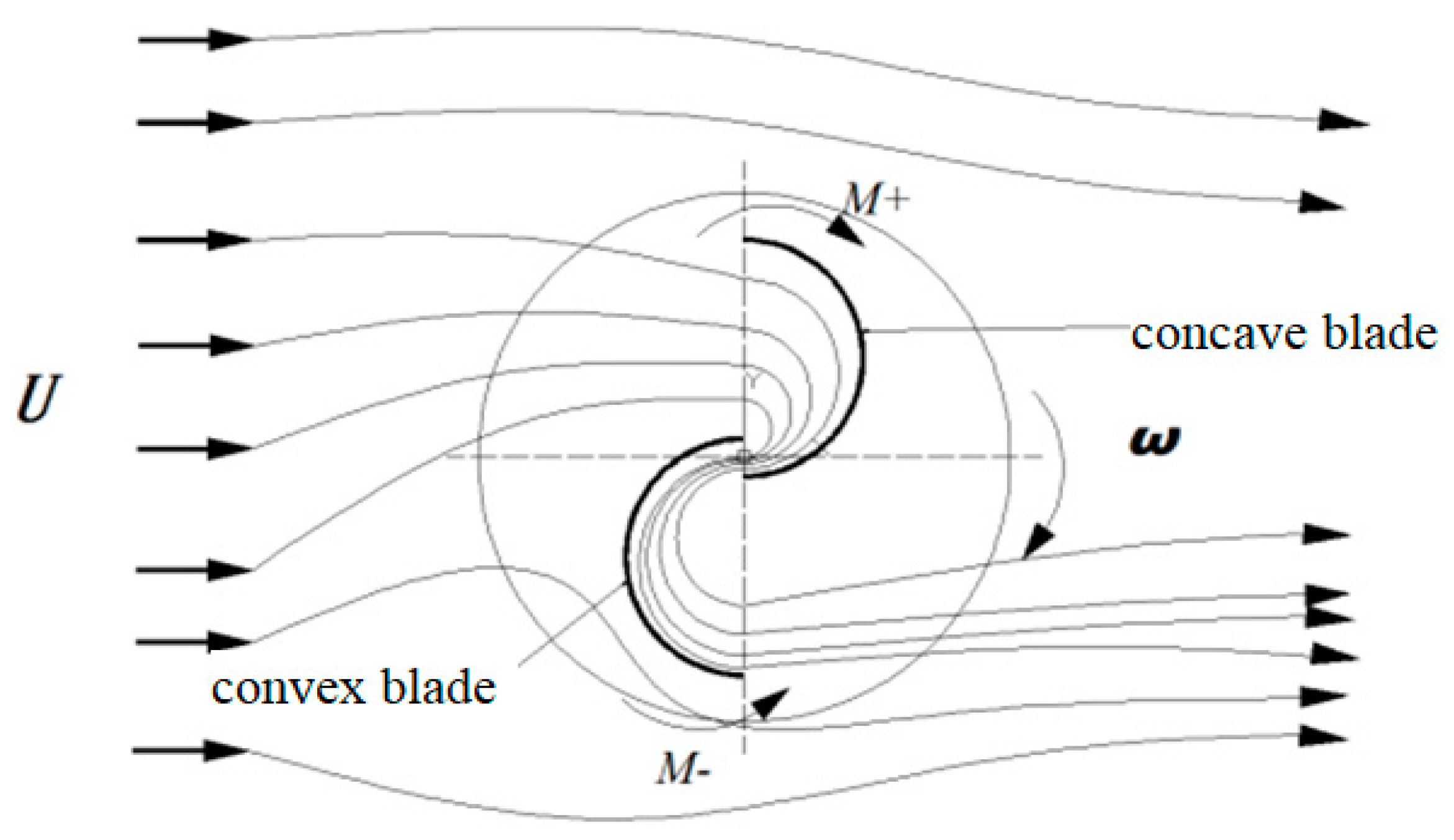
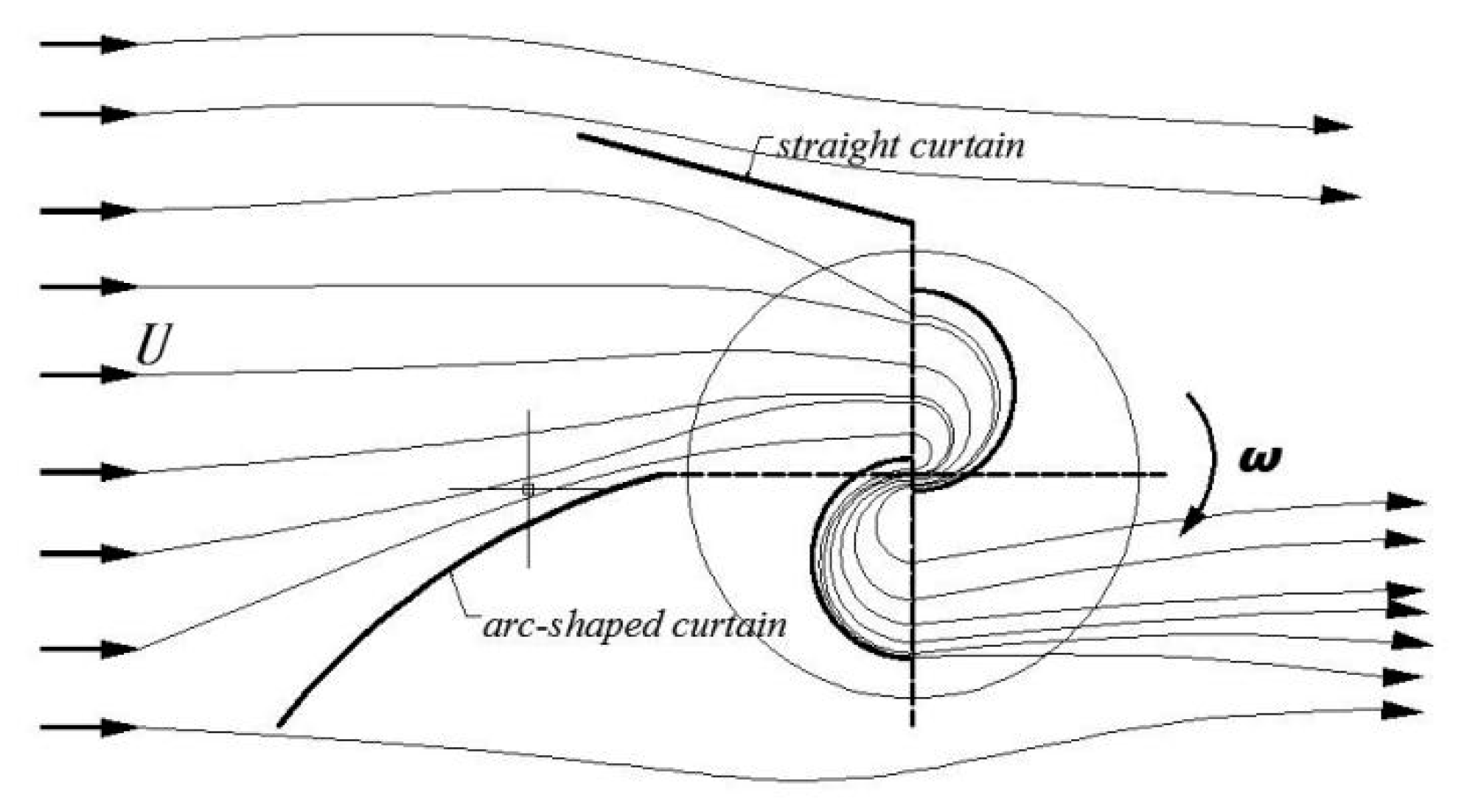
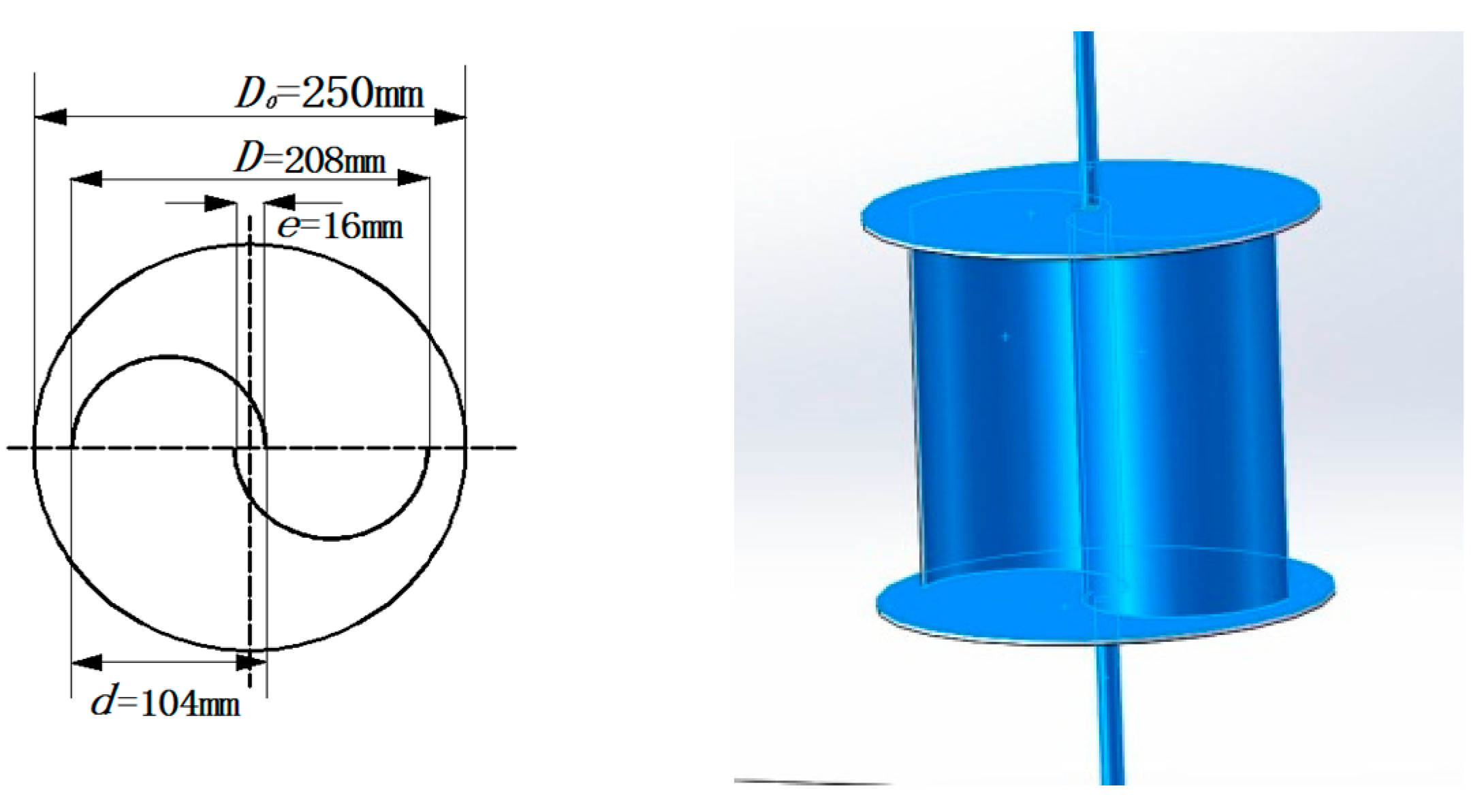
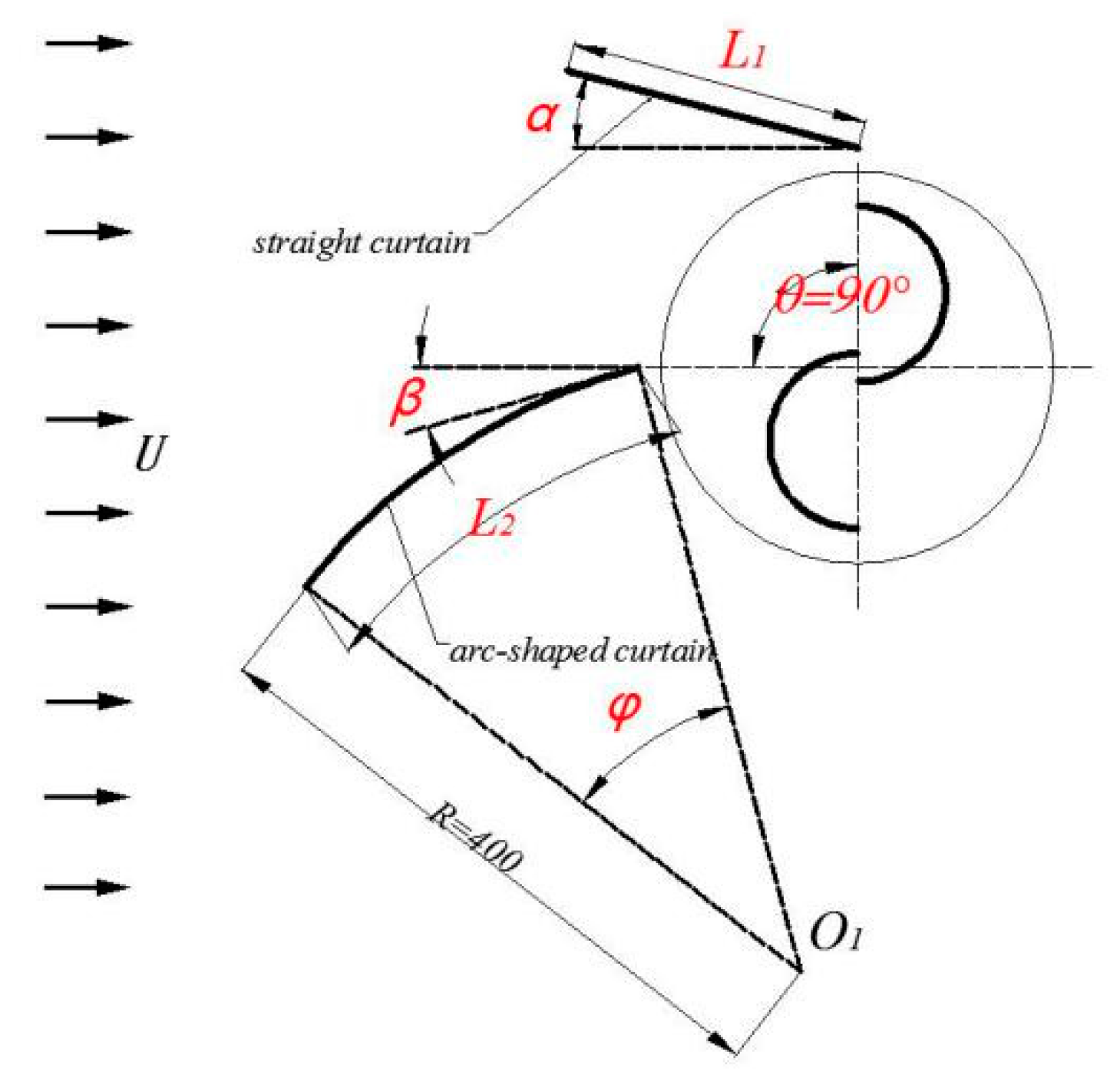
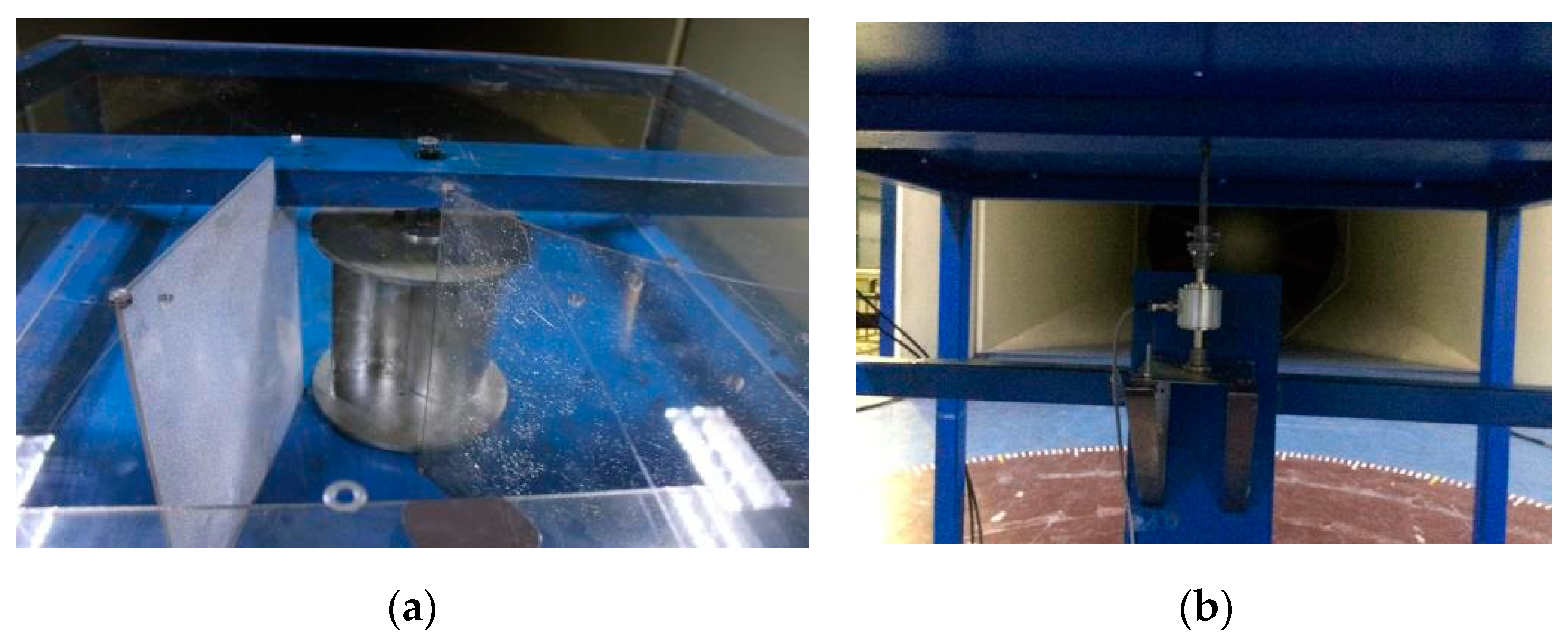
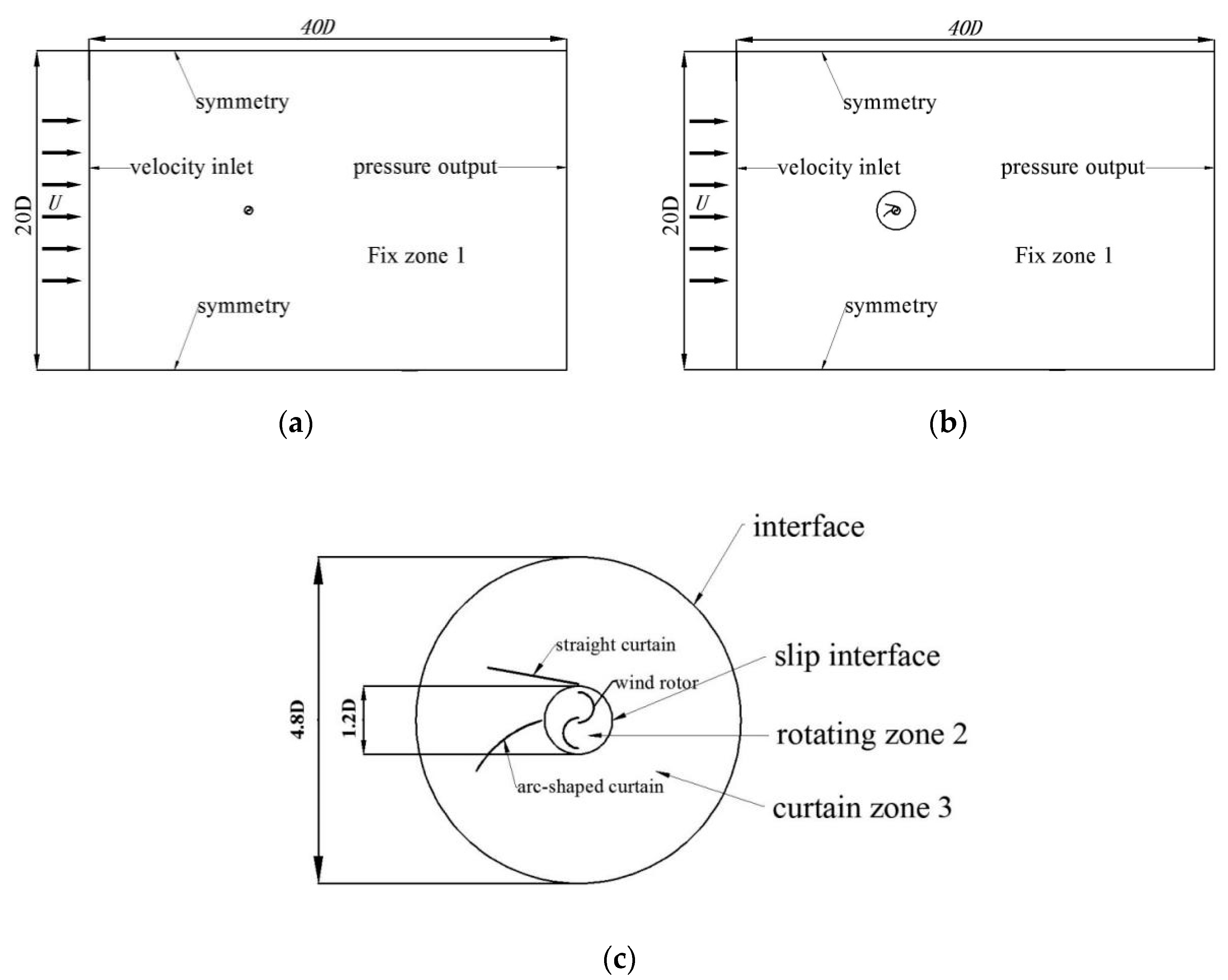
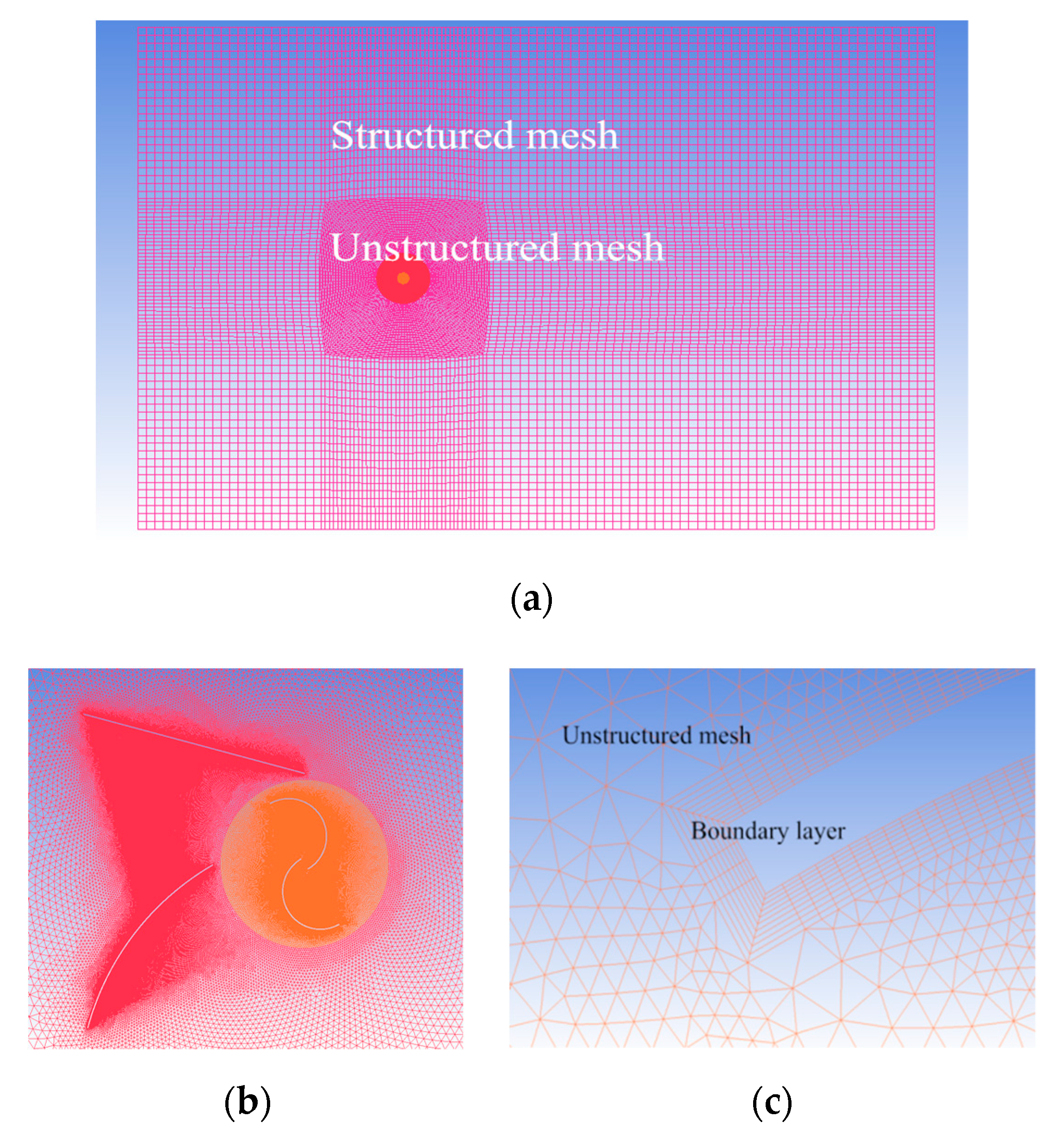
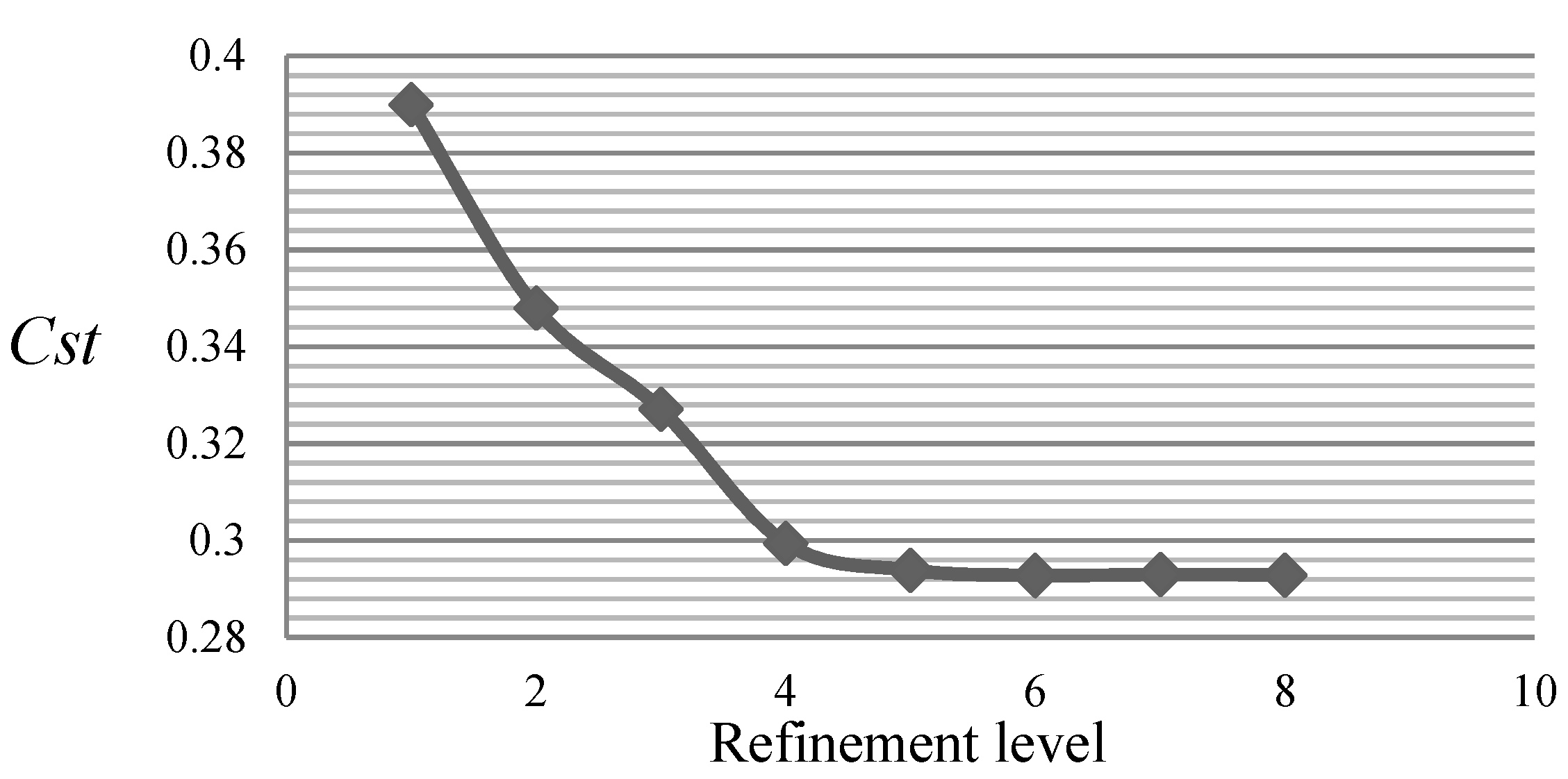
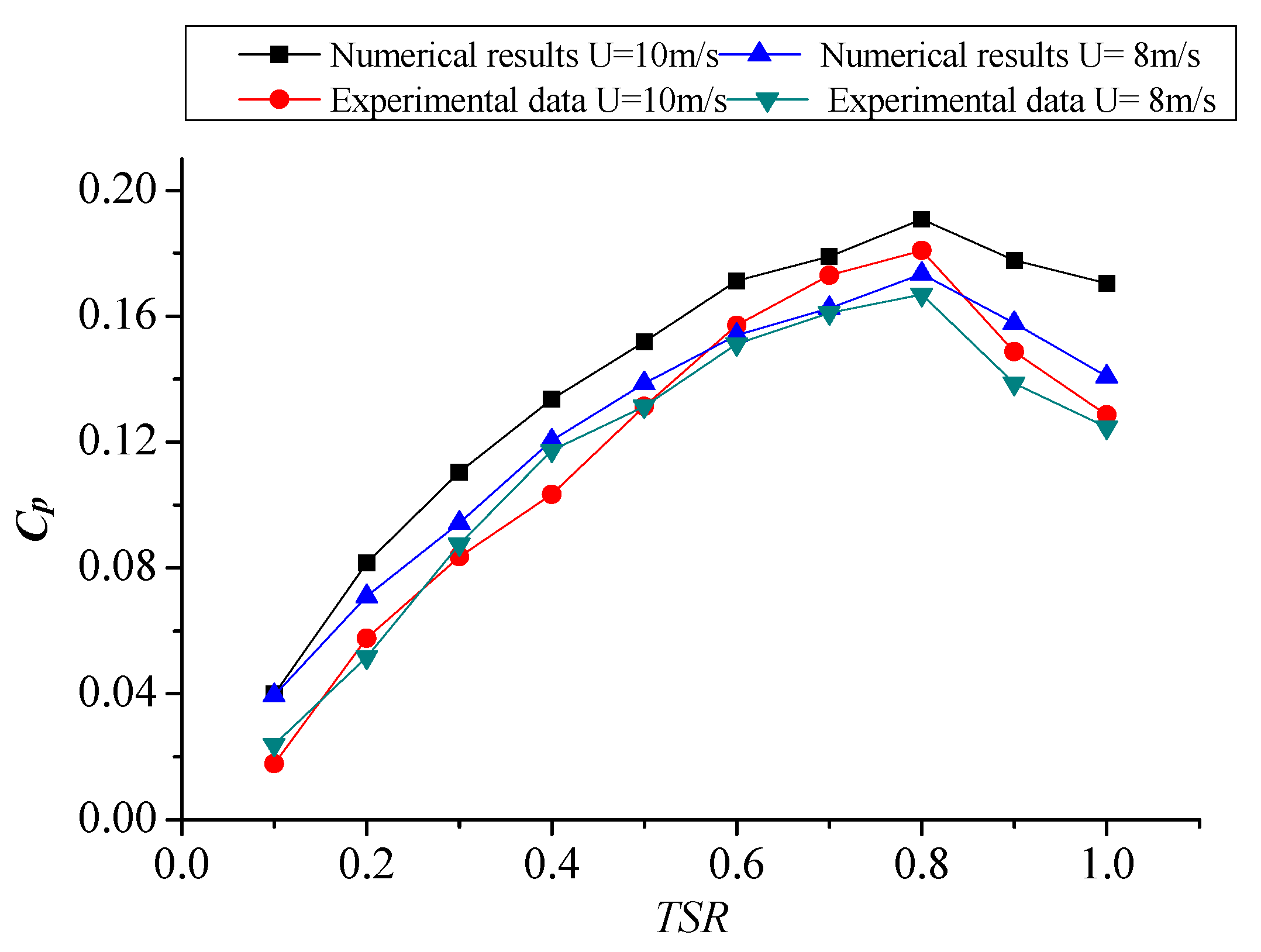
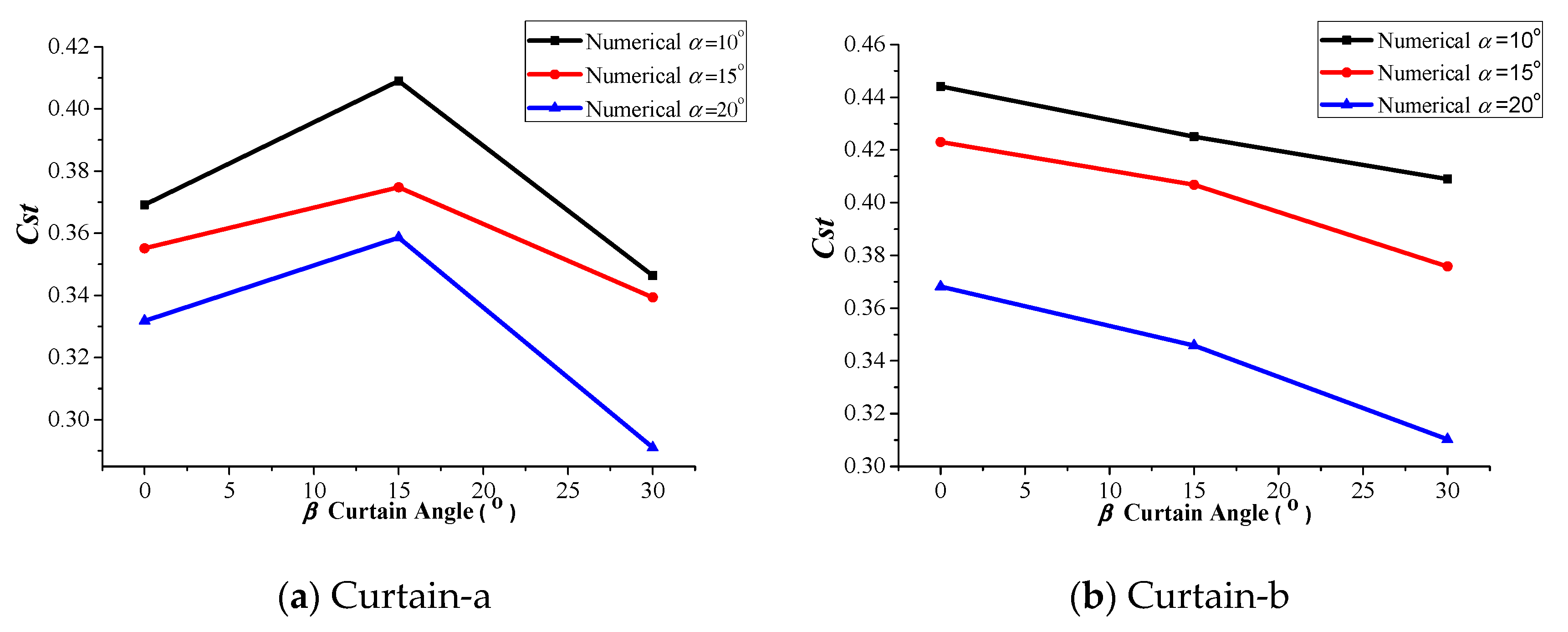
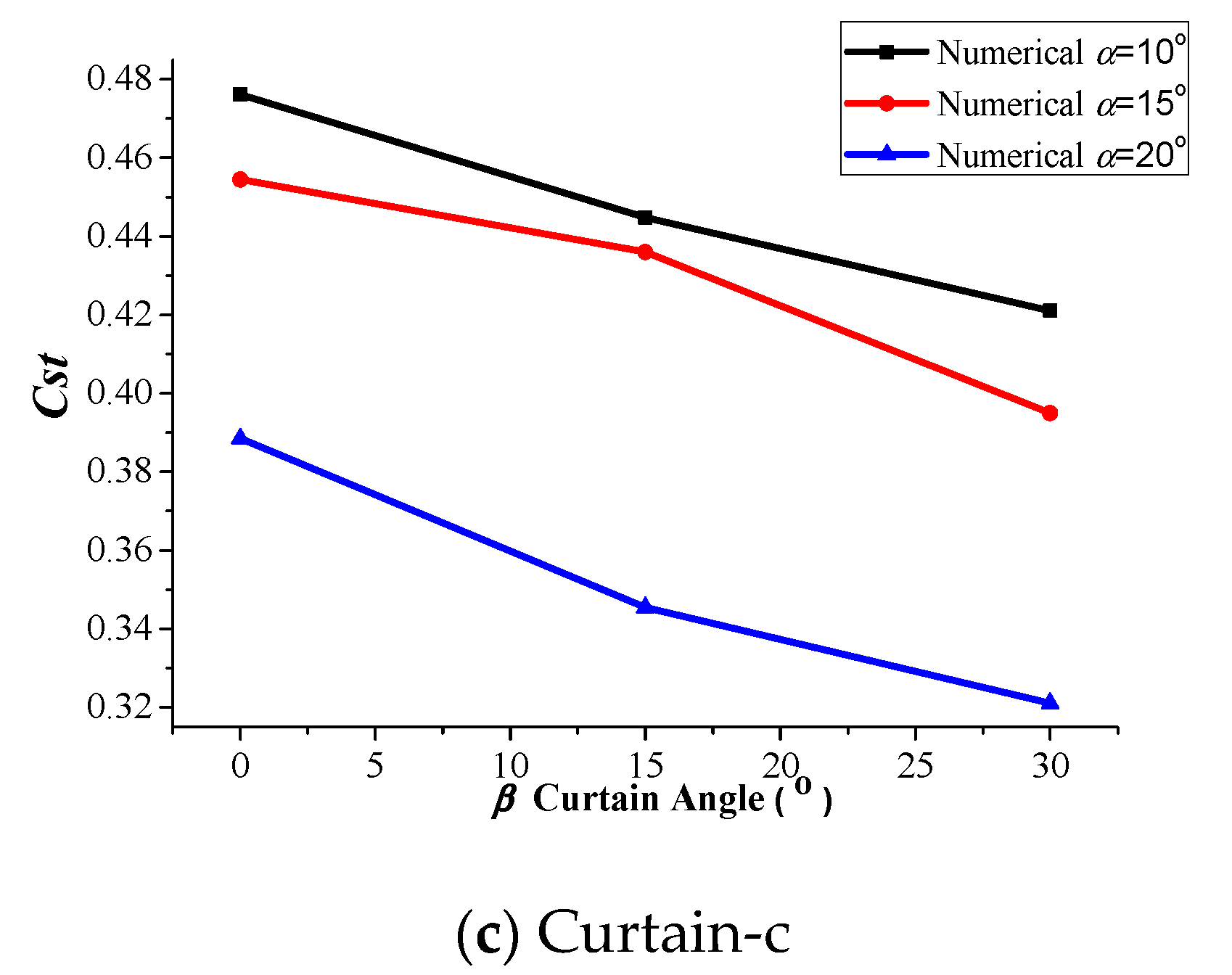
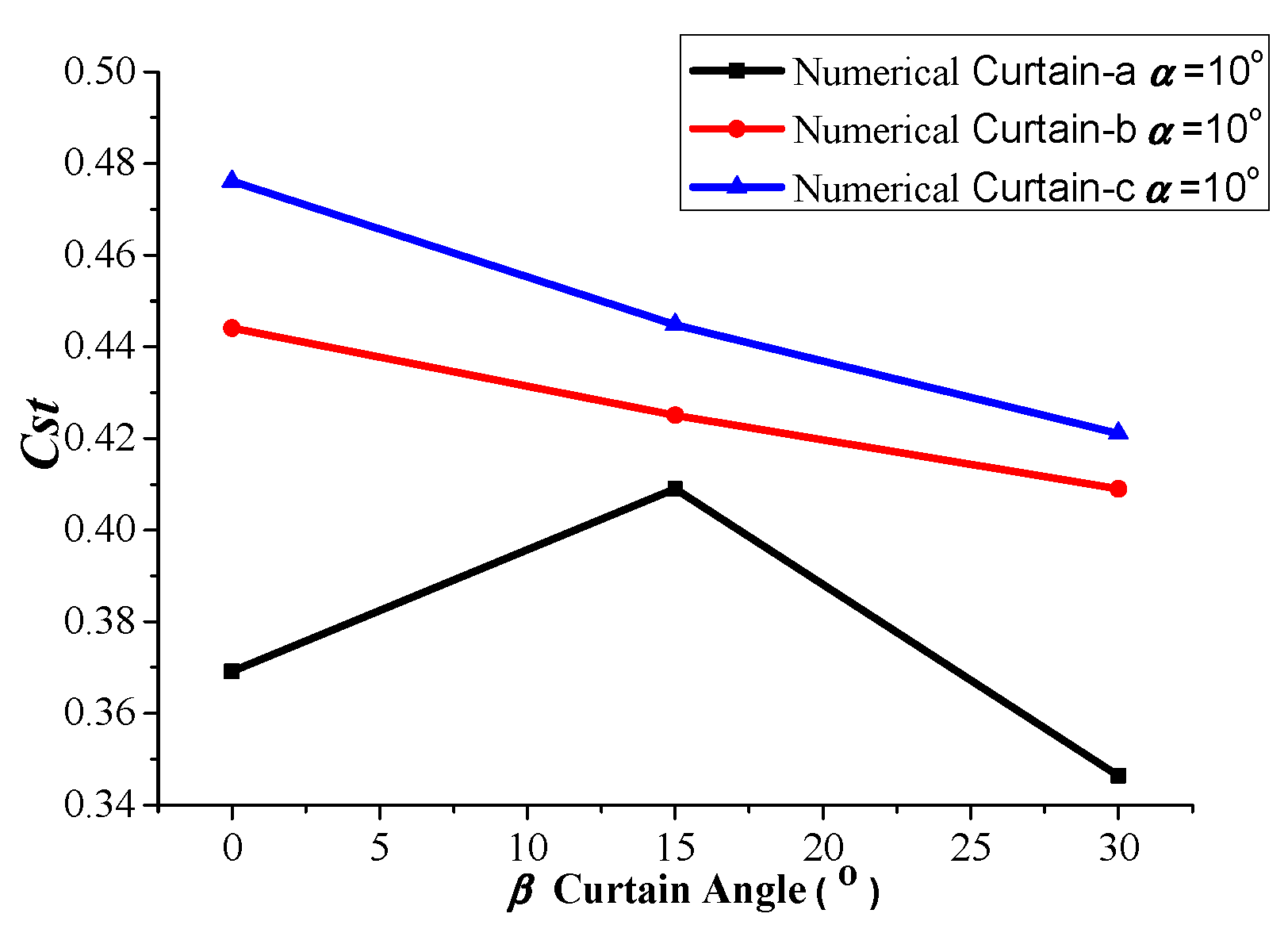
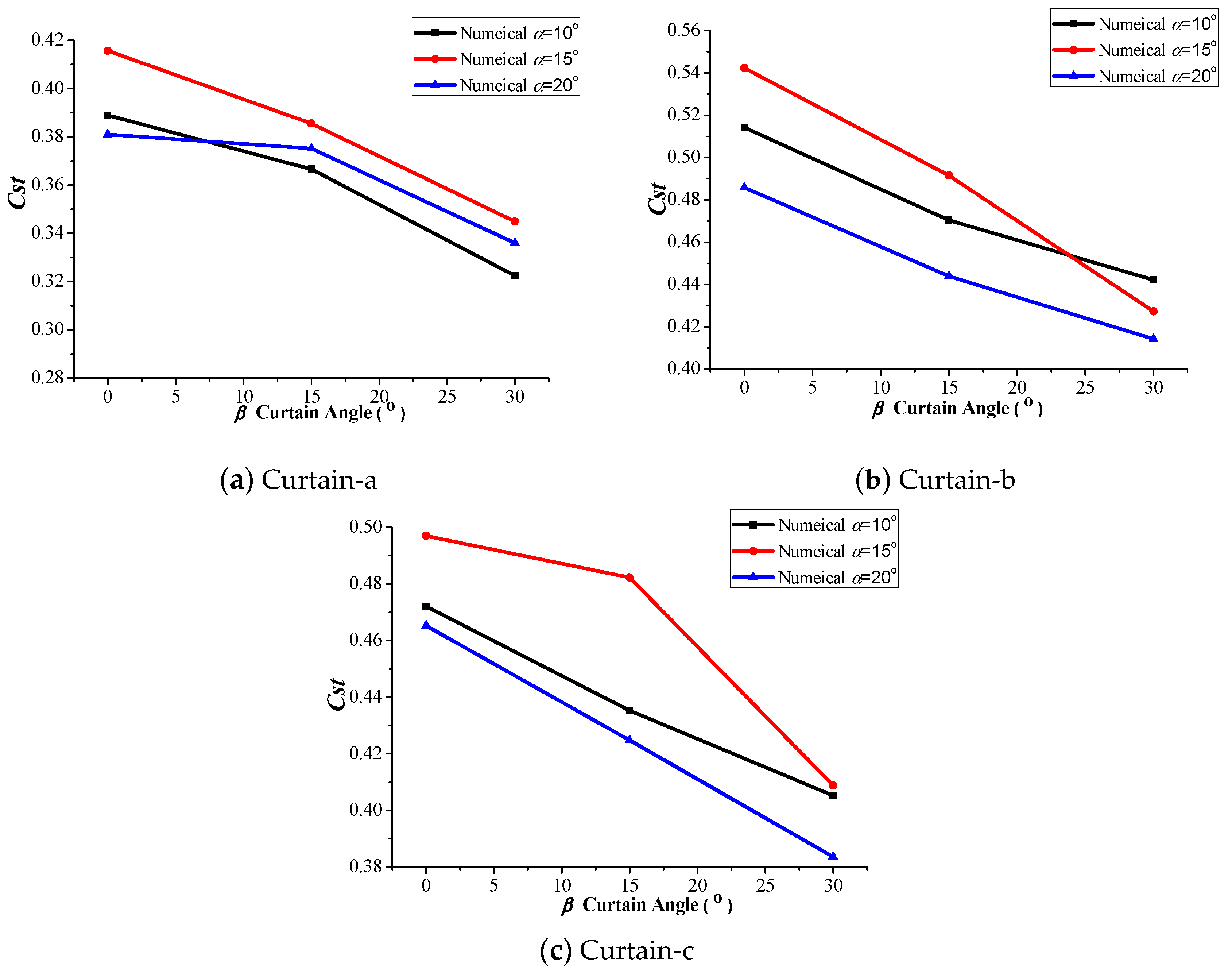
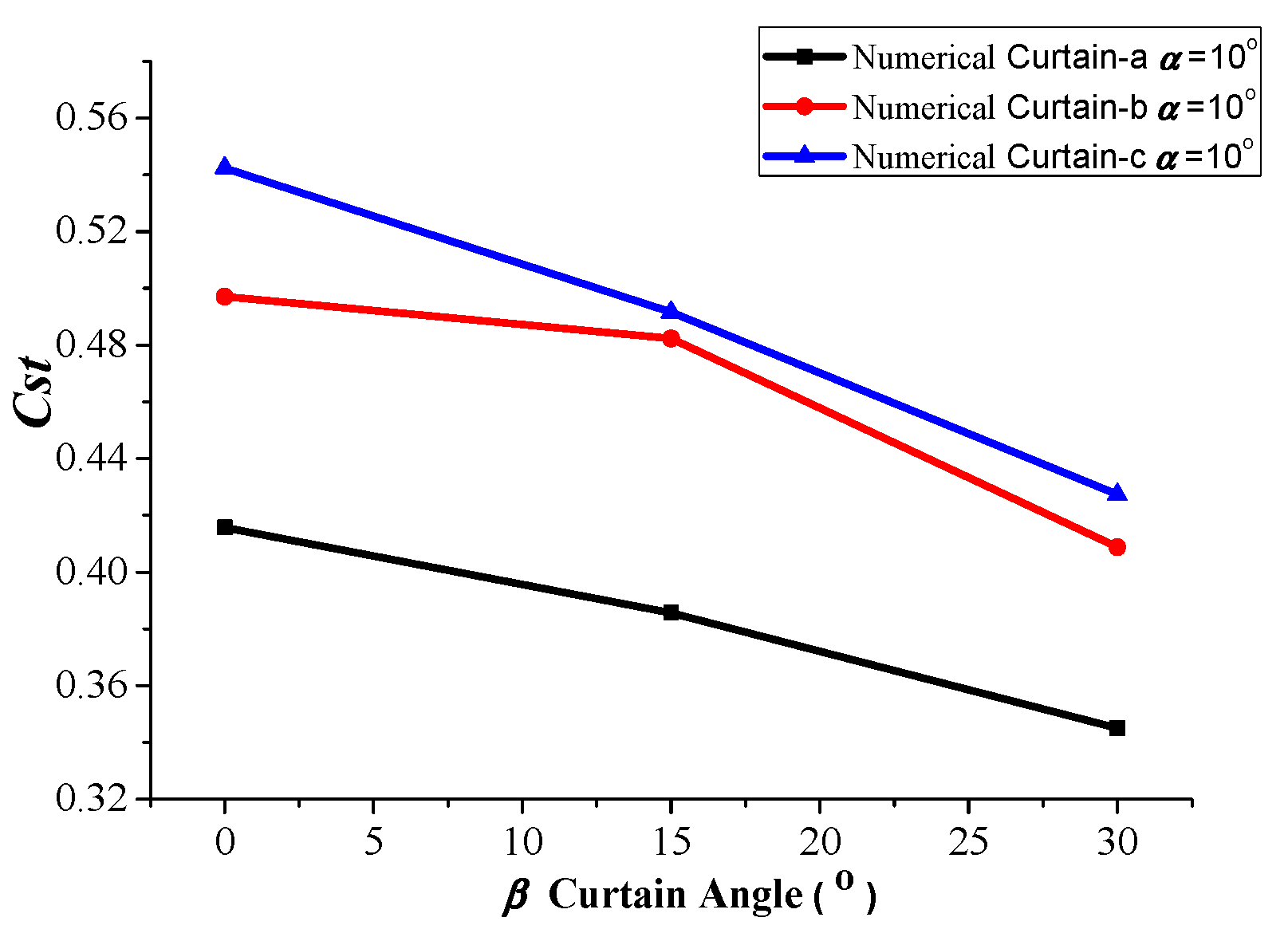
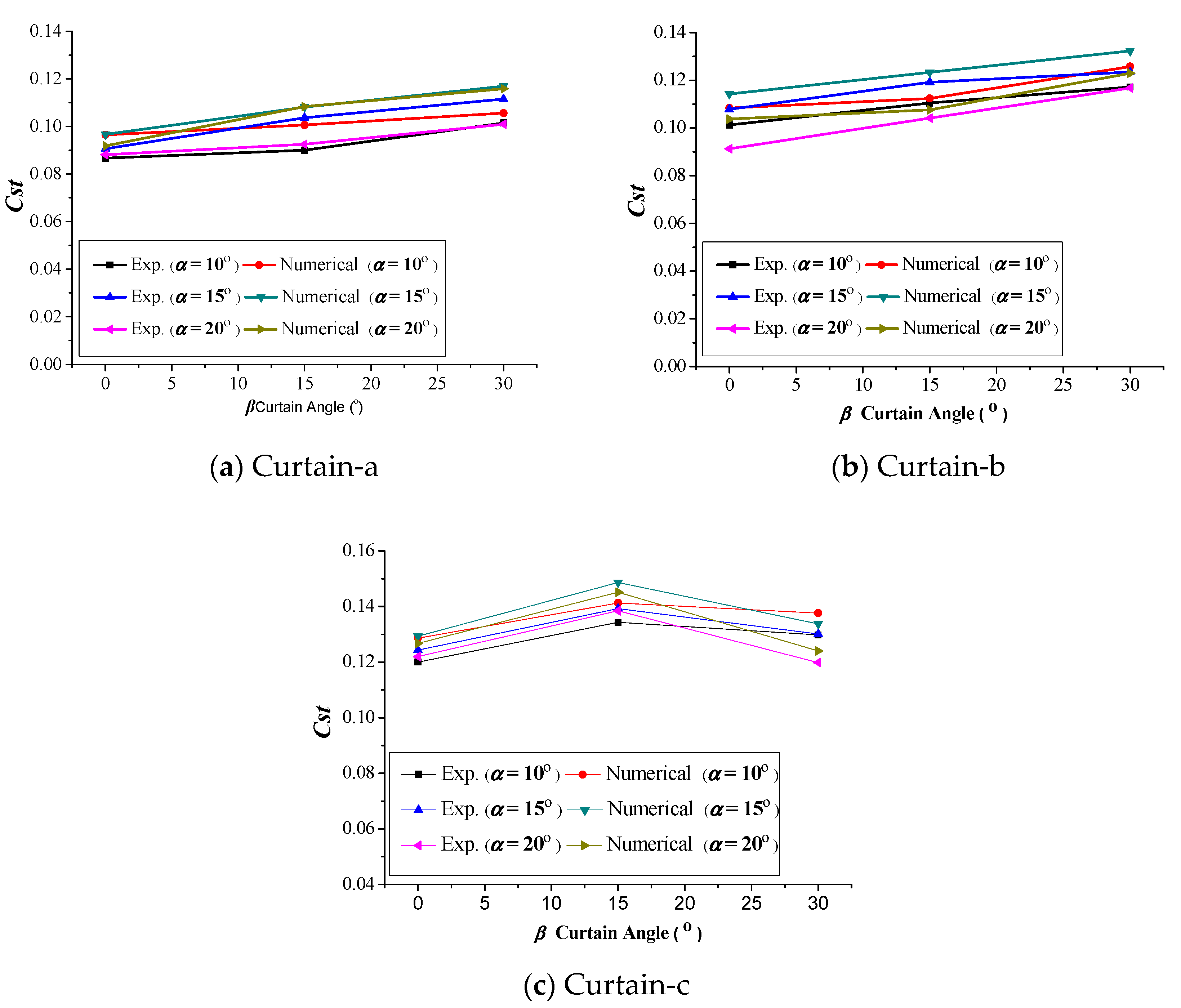
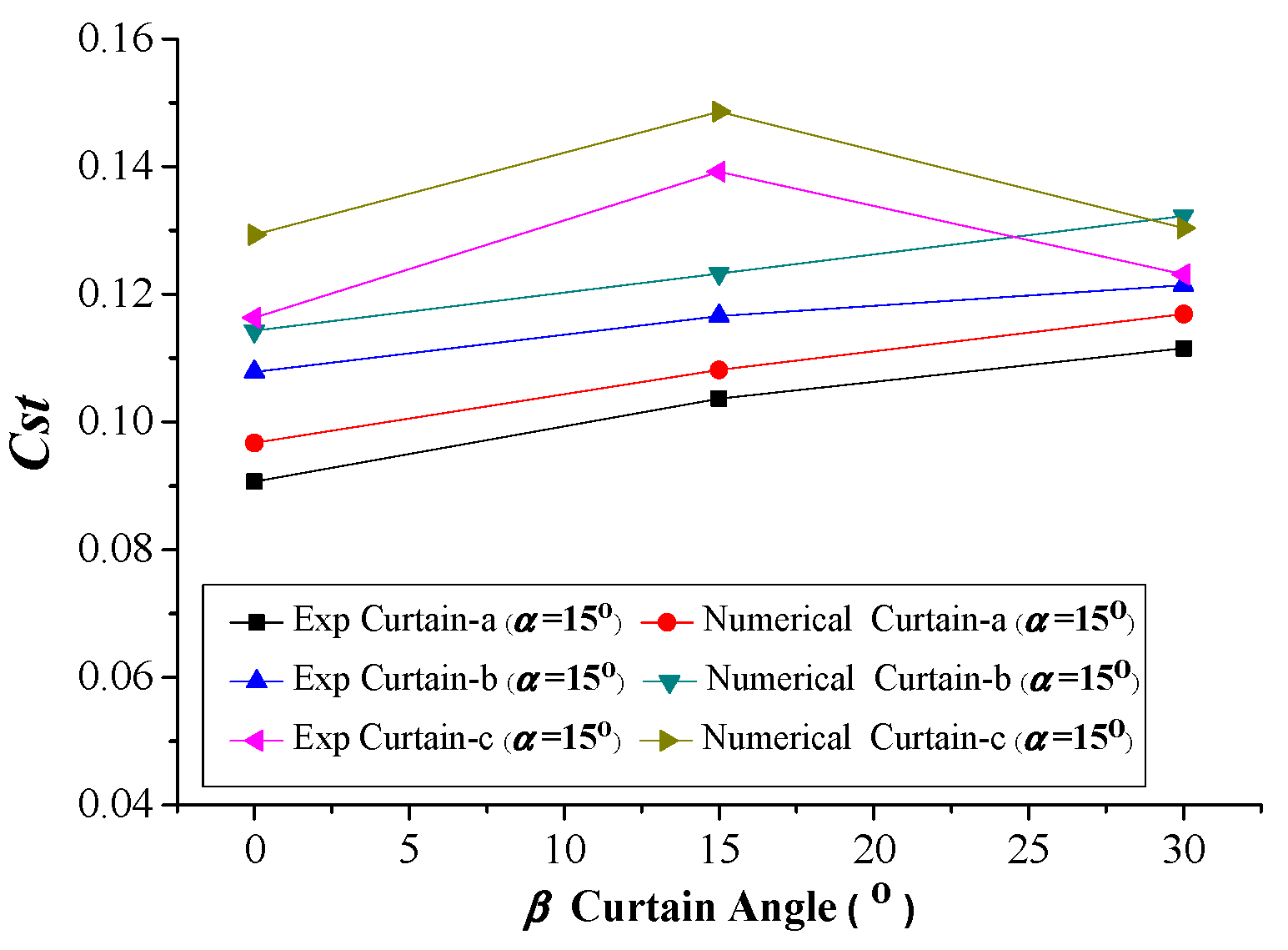
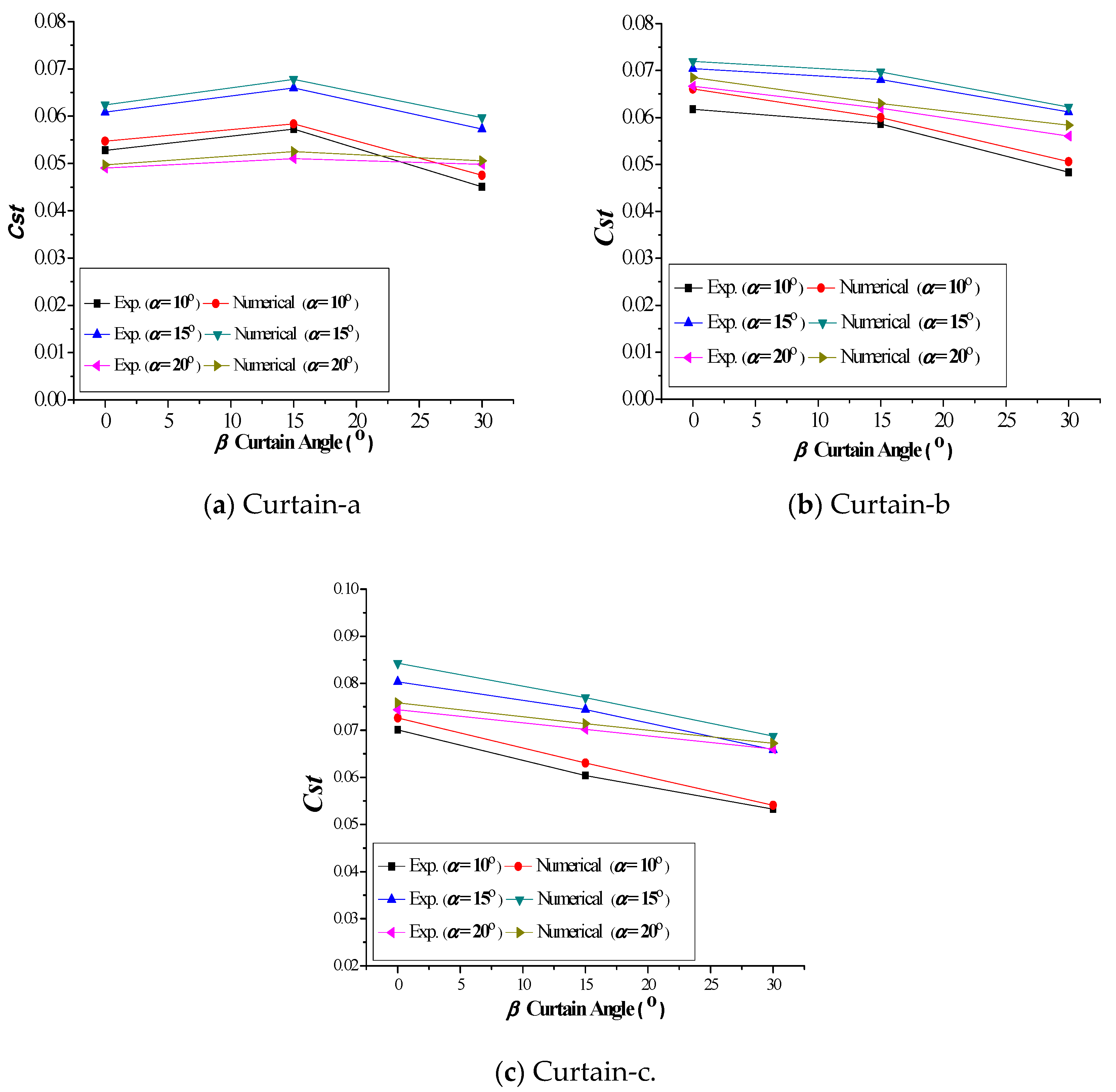

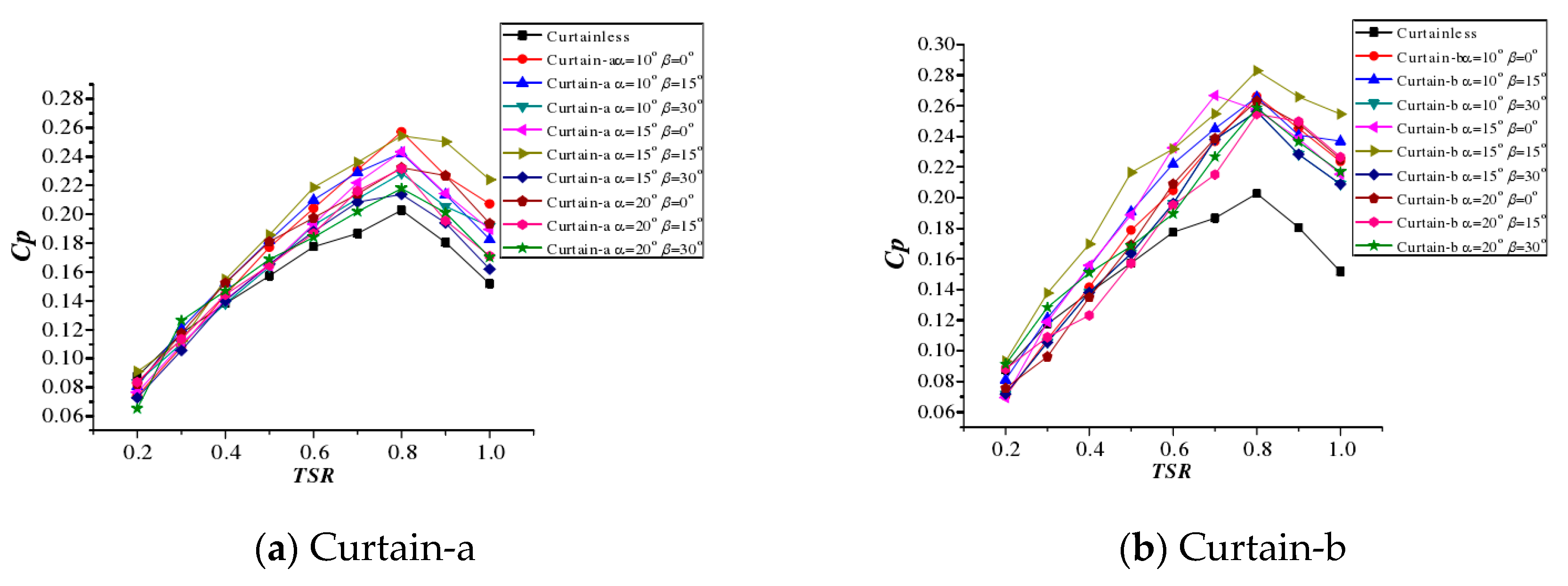
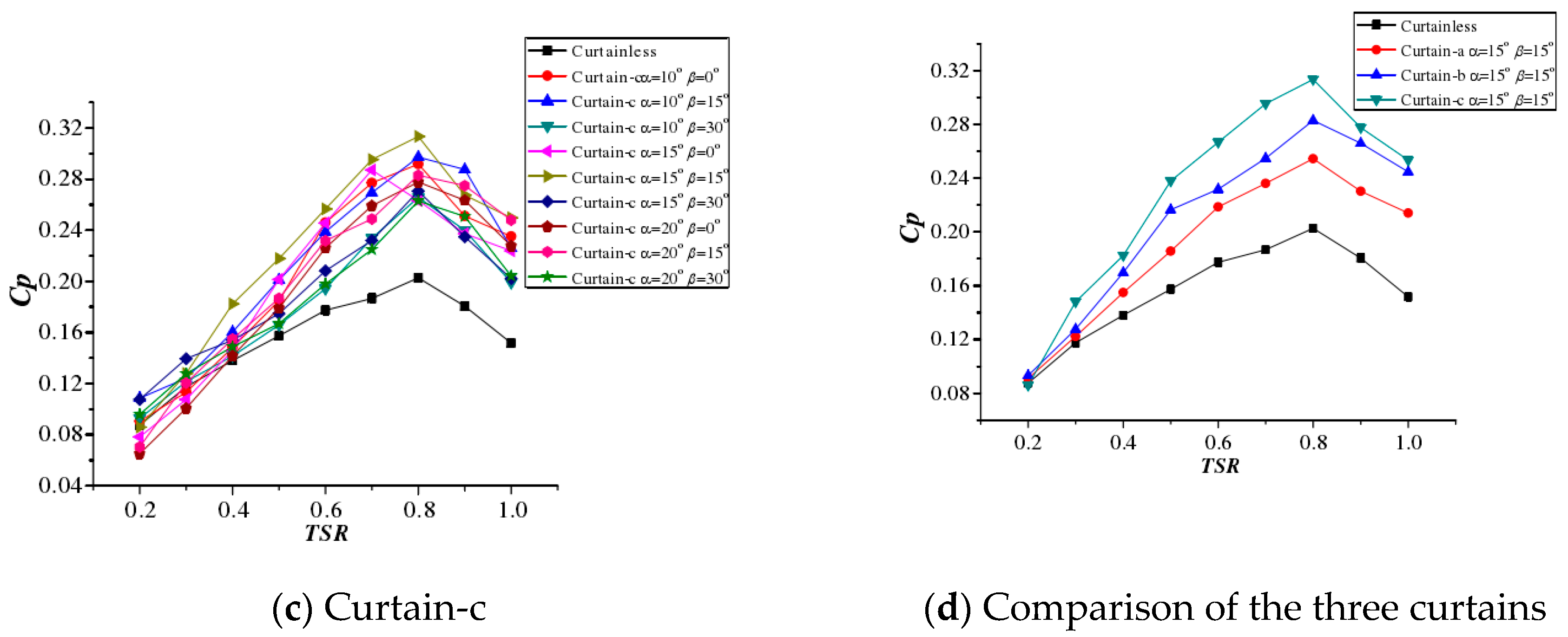
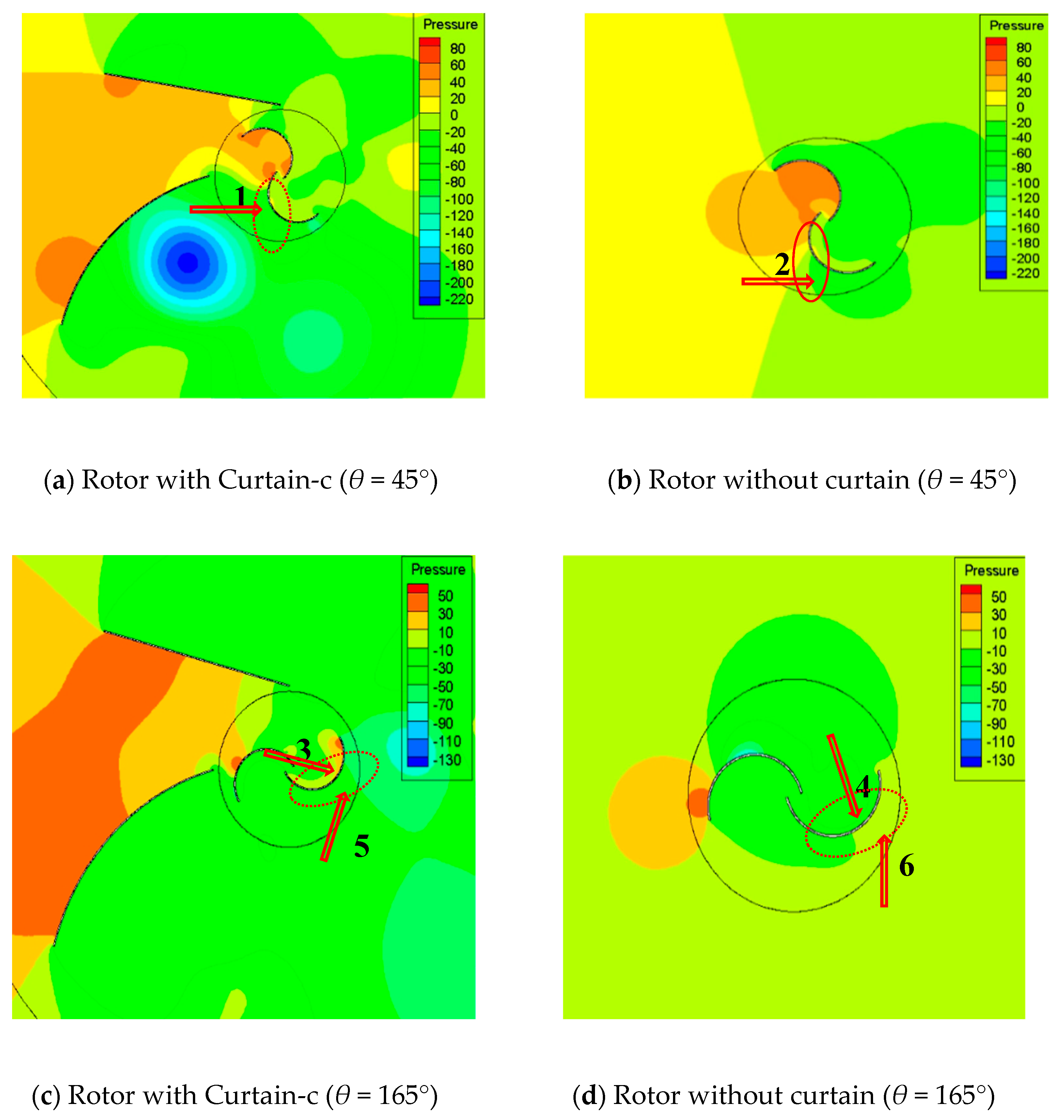
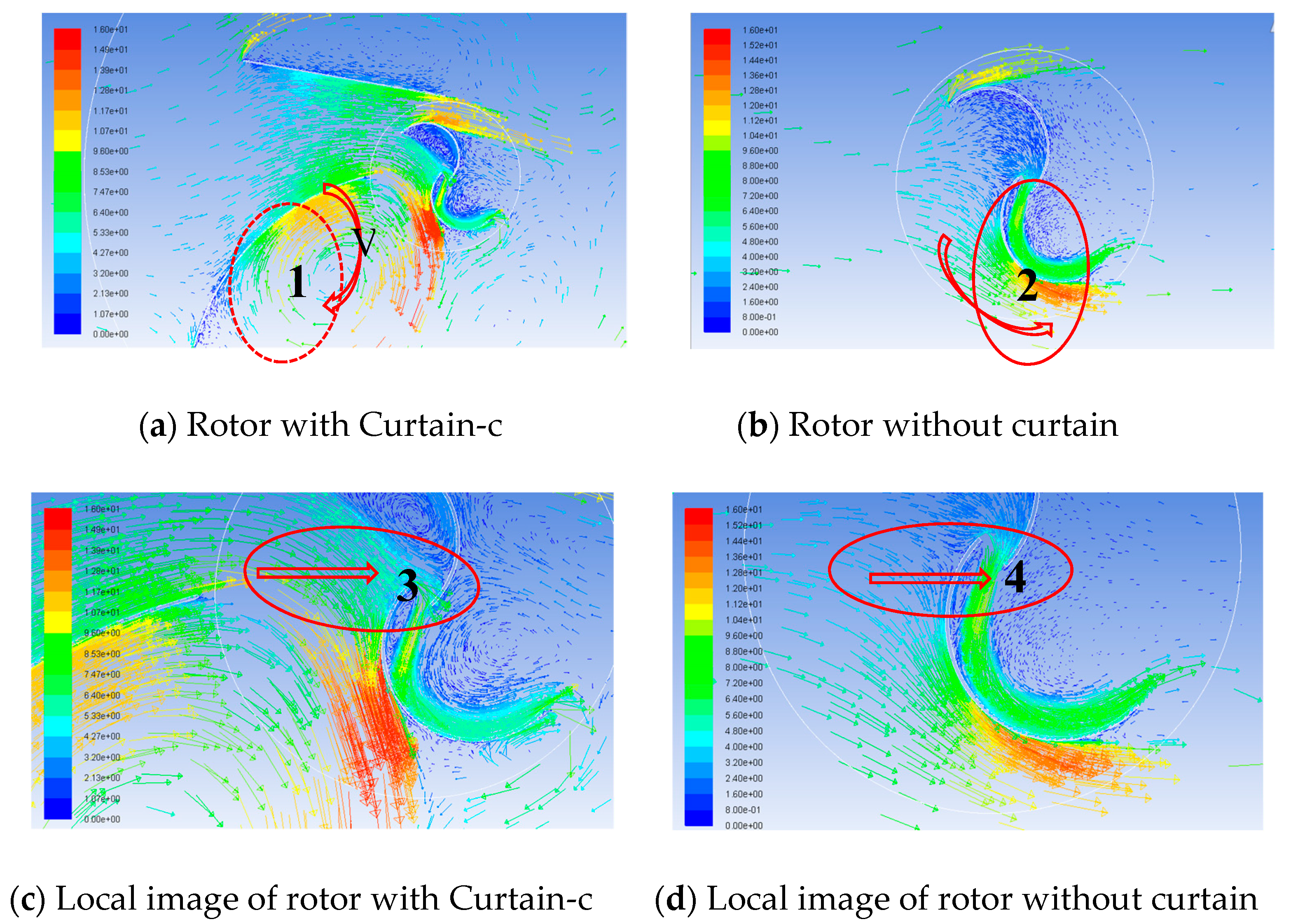
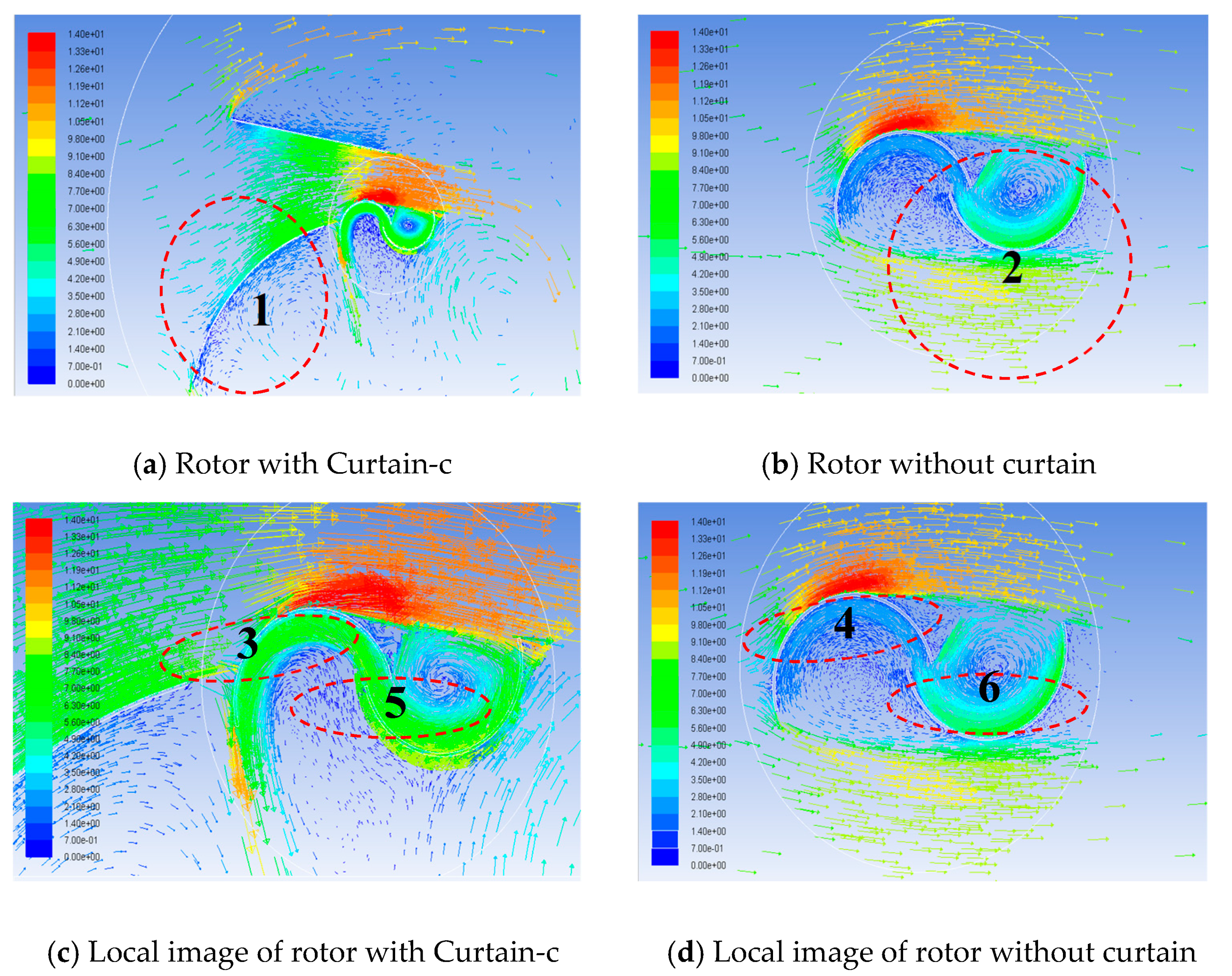
| Type of Curtain | L1 (mm) | R (mm) | φ (rad) | L2 (mm) |
|---|---|---|---|---|
| Curtain-a | 340 | 400 | π/6 | 210 |
| Curtain-b | π/4 | 314 | ||
| Curtain-c | π/3 | 419 |
| Type of Curtain | θ | α | β |
|---|---|---|---|
| No curtain | 45°, 60°, 150°, 165° | - | - |
| Curtain-a | 10°, 15°, 20° | 0°, 15°, 30° | |
| Curtain-b | |||
| Curtain-c |
| Refinement Level | Number of Elements | U(m/s) | Cst | Error (%) |
|---|---|---|---|---|
| 1 | 136,865 | 10 | 0.3921 | 40.04 |
| 2 | 154,238 | 0.3480 | 24.29 | |
| 3 | 181,511 | 0.3271 | 16.82 | |
| 4 | 196,688 | 0.2995 | 6.964 | |
| 5 | 245,974 | 0.2939 | 4.964 | |
| 6 | 274,076 | 0.2928 | 4.571 | |
| 7 | 317,048 | 0.2930 | 4.642 | |
| 8 | 332,802 | 0.2929 | 4.607 | |
| Experimental results | 0.28 | 0 | ||
Publisher’s Note: MDPI stays neutral with regard to jurisdictional claims in published maps and institutional affiliations. |
© 2020 by the authors. Licensee MDPI, Basel, Switzerland. This article is an open access article distributed under the terms and conditions of the Creative Commons Attribution (CC BY) license (http://creativecommons.org/licenses/by/4.0/).
Share and Cite
Zhang, H.; Li, Z.; Xin, D.; Zhan, J. Improvement of Aerodynamic Performance of Savonius Wind Rotor Using Straight-Arc Curtain. Appl. Sci. 2020, 10, 7216. https://doi.org/10.3390/app10207216
Zhang H, Li Z, Xin D, Zhan J. Improvement of Aerodynamic Performance of Savonius Wind Rotor Using Straight-Arc Curtain. Applied Sciences. 2020; 10(20):7216. https://doi.org/10.3390/app10207216
Chicago/Turabian StyleZhang, Hongfu, Zhiqiang Li, Dabo Xin, and Jian Zhan. 2020. "Improvement of Aerodynamic Performance of Savonius Wind Rotor Using Straight-Arc Curtain" Applied Sciences 10, no. 20: 7216. https://doi.org/10.3390/app10207216
APA StyleZhang, H., Li, Z., Xin, D., & Zhan, J. (2020). Improvement of Aerodynamic Performance of Savonius Wind Rotor Using Straight-Arc Curtain. Applied Sciences, 10(20), 7216. https://doi.org/10.3390/app10207216




